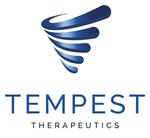- 21 months median OS in amezalpat arm vs. 15 in control arm
- 50% (20/40) of patients on amezalpat arm remain in survival follow up
- 0.65 hazard ratio, maintained since 0.59 observed in primary analysis 10 months earlier
- Early and persistent separation of survival curves
- OS is the primary regulatory endpoint for first-line HCC
- Company to host webcast conference call today at 8:30am ET
BRISBANE, Calif., June 20, 2024 (GLOBE NEWSWIRE) -- Tempest Therapeutics, Inc. (Nasdaq: TPST), a clinical-stage oncology company developing first-in-class1 therapeutics that combine both targeted and immune-mediated mechanisms, today announced new positive data from the ongoing global randomized Phase 1b/2 clinical study in which amezalpat2 (TPST-1120), Tempest’s PPAR⍺ antagonist, delivered a six-month improvement in median overall survival (“OS”) advantage when combined with atezolizumab and bevacizumab in a comparison to atezolizumab and bevacizumab alone in the first-line treatment of patients with unresectable or metastatic hepatocellular carcinoma (“HCC”).
“We are thrilled by these new survival data that build on the already meaningful data released in the fall showing the improvement of the amezalpat arm over atezolizumab and bevacizumab control across all study endpoints,” said Stephen Brady, president and chief executive officer of Tempest. “These new data come after 10 more months of follow-up since the last data analysis and show not only a strong hazard ratio of 0.65 favoring the amezalpat arm, but also a six-month improvement in the median overall survival with half the patients still in survival follow up, as well as observation of a survival advantage across key populations – results that we believe put amezalpat in a strong position for a successful pivotal Phase 3.”
At the cutoff date of February 14, 2024, the new data from 40 patients randomized to the amezalpat arm and 30 patients randomized to the control arm show:
- 21 month median OS for the amezalpat arm versus 15 month for the control arm, a six-month survival advantage
- 20/40 patients remain in survival follow up in the amezalpat arm, compared to 9/30 patients in the control arm
- 0.65 hazard ratio (“HR”) for OS, revealing a stable HR since the top-line analysis 10 months earlier when the HR was 0.59
- Manageable safety profile consistent with Phase 1 data
The earlier top-line data analysis, dated April 20, 2023, had a median follow up of 9.2 and 9.9 months for the amezalpat and control arms, respectively, and showed:
- Confirmed objective response rate (“cORR” or “confirmed ORR”) of 30% for the amezalpat arm versus 13.3% for the control arm;
- Biomarker subpopulation findings were consistent with the mechanism of action of amezalpat
- Patients with b-catenin activating mutations (21% in this study (n=7)) showed a cORR of 43% and a disease control rate (“DCR”) of 100% in the amezalpat arm
- The amezalpat arm was consistently active across both PD-L1 positive and PD-L1 negative tumors, with a cORR of 27% in the amezalpat arm compared to 7% for the control arm in PD-L1 negative tumors
- Amezalpat remains well tolerated, with safety data comparable between the two arms
- The randomized arms were generally well balanced at baseline
ORR was determined by RECIST v1.1, and confirmed responses included at least two scans. Tempest retains all product rights to amezalpat.
Conference Call & Webcast Information
Tempest will host a webcast conference call today, June 20, 2024 at 8:30am ET.
To join the conference call via phone and participate in the live Q&A session, please pre-register online here to receive a telephone number and unique passcode required to enter the call. The live webcast and audio archive of the presentation may be accessed on the investor section of the Tempest website at https://ir.tempesttx.com/. The webcast will be available for replay for 30 days.
About the Randomized Clinical Trial
The Phase 1b/2 global randomized HCC study is part of Roche’s Morpheus program and evaluates amezalpat in combination with atezolizumab and bevacizumab versus atezolizumab and bevacizumab, the standard of care, in patients with unresectable or metastatic HCC not previously treated with systemic therapy. The trial randomized 70 patients to receive either amezalpat with atezolizumab + bevacizumab or a contemporaneous control arm of atezolizumab + bevacizumab alone at approximately 25 sites worldwide, including in the United States, Europe, and Asia. The primary efficacy endpoint was confirmed objective response rate, and key secondary endpoints including PFS and OS. Under the terms of the clinical collaboration agreement, Roche is managing the study operations for this global, multicenter trial and Tempest retains all product rights.
About Amezalpat (TPST-1120)
Amezalpat is an oral, small molecule, selective PPAR⍺ antagonist. Tempest’s data suggest that amezalpat treats cancer by targeting tumor cells directly and by modulating immune suppressive cells and angiogenesis in the tumor microenvironment. In an ongoing global randomized phase 1b/2 study of amezalpat in combination with atezolizumab and bevacizumab in first-line patients with advanced HCC, the amezalpat arm showed clinical superiority across multiple study endpoints when compared to atezolizumab and bevacizumab alone, the standard of care. These randomized data were supported by positive results observed in the Phase 1 clinical trial in patients with heavily pretreated advanced solid tumors.
About Hepatocellular Carcinoma
HCC is an aggressive cancer with rising mortality and is projected to become the third leading cause of cancer death by 2030.3 Every year, more than 900,000 people worldwide are diagnosed with HCC.4 Incidence and mortality are highest in East Asia and are increasing in parts of Europe and the US.5 In the US, HCC represents the fastest-rising cause of cancer-related death.3
Nine out of ten cases of HCC are caused by chronic liver disease, which includes chronic hepatitis B and C infection, non-alcoholic fatty liver disease (NAFLD), non-alcoholic steatohepatitis (NASH), alcohol-related liver disease (ALD) and cirrhosis resulting from these conditions.6
Even if diagnosed in the early stage, an estimated 70-80% of people with early-stage HCC experience disease recurrence following surgery.7 Early recurrence is associated with poorer prognosis and shorter survival.5,8 Tumor size, number of tumors, and portal vein invasion are associated with an increased risk of recurrence.6
About Tempest Therapeutics
Tempest Therapeutics is a clinical-stage biotechnology company advancing a diverse portfolio of small molecule product candidates containing tumor-targeted and/or immune-mediated mechanisms with the potential to treat a wide range of tumors. The company’s novel programs range from early research to later-stage investigation in a randomized global study in first-line cancer patients. Tempest is headquartered in Brisbane, California. More information about Tempest can be found on the company’s website at www.tempesttx.com.
Forward-Looking Statements
This press release contains forward-looking statements (including within the meaning of Section 21E of the Securities Exchange Act of 1934, as amended, and Section 27A of the Securities Act of 1933, as amended (the “Securities Act”) concerning Tempest Therapeutics, Inc. (“Tempest Therapeutics”). These statements may discuss goals, intentions, and expectations as to future plans, trends, events, results of operations or financial condition, or otherwise, based on current beliefs of the management of Tempest Therapeutics, as well as assumptions made by, and information currently available to, management of Tempest Therapeutics. Forward-looking statements generally include statements that are predictive in nature and depend upon or refer to future events or conditions, and include words such as “may,” “will,” “should,” “would,” “could”, “expect,” “anticipate,” “plan,” “likely,” “believe,” “estimate,” “project,” “intend,” and other similar expressions. All statements that are not historical facts are forward-looking statements, including any statements in this release regarding the therapeutic benefit and regulatory development of amezalpat and the favorable results of clinical trials. Forward-looking statements are based on information available to Tempest Therapeutics as of the date hereof and are not guarantees of future performance. Actual results could differ materially from those contained in any forward-looking statement. These and other risks are described in greater detail in the Form 10-Q filed by Tempest Therapeutics with the Securities and Exchange Commission on May 9, 2024. Except as required by applicable law, Tempest Therapeutics undertakes no obligation to revise or update any forward-looking statement, or to make any other forward-looking statements, whether as a result of new information, future events or otherwise. These forward-looking statements should not be relied upon as representing Tempest Therapeutics’ views as of any date subsequent to the date of this press release and should not be relied upon as prediction of future events. In light of the foregoing, investors are urged not to rely on any forward-looking statement in reaching any conclusion or making any investment decision about any securities of Tempest Therapeutics.
Investor Contacts:
Sylvia Wheeler
Wheelhouse Life Science Advisors
swheeler@wheelhouselsa.com
Aljanae Reynolds
Wheelhouse Life Science Advisors
areynolds@wheelhouselsa.com
1 If approved by the FDA
2 Recommended International Nonproprietary Name (INN), April 22, 2024
3 Rahib, L. et al. Projecting cancer incidence and deaths to 2030: the unexpected burden of thyroid, liver, and pancreas cancers in the United States. Cancer Res. 74, 2913-2921 (2014).
4 World Health Organization. Liver Cancer Factsheet. Globocan. 2020. Available at: https://gco.iarc.fr/today/data/factsheets/cancers/11-Liver-fact-sheet.pdf. Last accessed: April 2023.
5 Llovet, J. M., Kelley, R. K., Villanueva, A., et al. Hepatocellular carcinoma. Nature Reviews Disease Primers. 2021, 7(1), 6.
6 Office for Health Improvement & Disparities. Liver disease profiles: November 2021 update. Available at: https://www.gov.uk/government/statistics/liver-disease-profiles-november-2021-update/liver-disease-profiles-november-2021-update. Last accessed: April 2023.
7 Hack SP, Spahn J, Chen M et al. IMbrave 050: a Phase III trial of atezolizumab plus bevacizumab in high-risk hepatocellular carcinoma after curative resection or ablation. Future Oncology. 2020 May;16(15):975-989.
8 Saito A, Toyoda H, Kobayashi M et al. Prediction of early recurrence of hepatocellular carcinoma after resection using digital pathology images assessed by machine learning. Modern Pathology. 2021. 34, 417-425.









